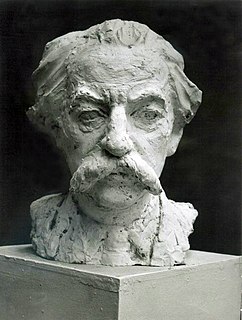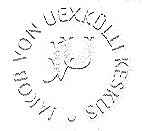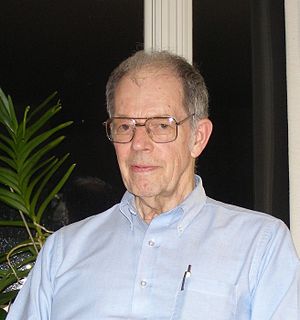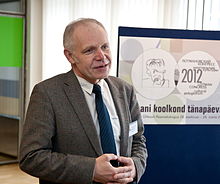
Juri Lotman was a prominent Russian-Estonian literary scholar, semiotician, and historian of Russian culture, who worked at the University of Tartu. He was elected a member of the British Academy (1977), Norwegian Academy of Science and Letters (1987), Royal Swedish Academy of Sciences (1989) and Estonian Academy of Sciences (1990). He was a founder of the Tartu–Moscow Semiotic School. The number of his printed works exceeds 800 titles. His archive which includes his correspondence with a number of Russian and Western intellectuals, is immense.
Biosemiotics is a field of semiotics and biology that studies the prelinguistic meaning-making, biological interpretation processes, production of signs and codes and communication processes in the biological realm.
Zoosemiotics is the semiotic study of the use of signs among animals, more precisely the study of semiosis among animals, i.e. the study of how something comes to function as a sign to some animal. It is the study of animal forms of knowing.

Jakob Johann Freiherr von Uexküll was a Baltic German biologist who worked in the fields of muscular physiology and animal behaviour studies and was an influence on the cybernetics of life. However, his most notable contribution is the notion of Umwelt, used by semiotician Thomas Sebeok and philosopher Martin Heidegger. His works established biosemiotics as a field of research.

Thomas Albert Sebeok was a Hungarian-born American polymath, semiotician, and linguist. As one of the founders of the biosemiotics field, he studied non-human and cross-species signaling and communication. He is also known for his work in the development of long-time nuclear waste warning messages, in which he worked with the Human Interference Task Force to create methods for keeping the inhabitants of Earth away from buried nuclear waste that will still be hazardous 10,000 or more years in the future.

John Deely was an American philosopher and semiotician. He was a professor of philosophy at Saint Vincent College and Seminary in Latrobe, Pennsylvania. Prior to this, he held the Rudman Chair of Graduate Philosophy at the Center for Thomistic Studies, located at the University of St. Thomas (Houston).

Claus Emmeche is a Danish theoretical biologist and philosopher. He is associate professor at the University of Copenhagen, and is head of the Center for the Philosophy of Nature and Science Studies at the Faculty of Science.
Martin Krampen was a leading German semiotician, semiotics Professor in Göttingen.
Giorgio Prodi was an Italian medical scientist, oncologist and semiotician.
Olevi Kull was an Estonian professor at the University of Tartu known for his contribution to ecology. Following his death, a memorial fund was established by donations in his memory, which provides travel stipends to students in the fields of plant ecophysiology, forest ecology and ecosystem ecology.
The International Society for Biosemiotic Studies (ISBS) is an academic society for the researchers in semiotic biology. The Society was established in 2005. Its official journal is Biosemiotics, published by Springer and launched in 2008.
Ülle Kukk is an Estonian botanist and conservationist.
The Estonian Institute of Zoology and Botany (ZBI) was a zoological and botanical research institute based in Tartu, Estonia. It was founded in 1947. Since 1997, it belonged to the Estonian University of Life Sciences as a central biological research institute in the country. On January 1, 2005 it was merged into the Institute of Agricultural and Environmental Sciences.

Jesper Hoffmeyer was a professor at the University of Copenhagen Institute of Biology, and a leading figure in the emerging field of biosemiotics. He was the President of the International Society for Biosemiotic Studies (ISBS) from 2005 to 2015, co-editor of the journal Biosemiotics and the Springer Book series in Biosemiotics. He authored the books Biosemiotics: An Examination into the Signs of Life and the Life of Signs and Signs of Meaning in the Universe and edited A Legacy for Living Systems: Gregory Bateson as Precursor to Biosemiotics.

Jakob von Uexküll Centre is an Estonia-based organisation for the work with the legacy of biologist, philosopher and semiotician Jakob von Uexküll. The Centre owns the major archive of his works in the world.
Ecosemiotics is a branch of semiotics in its intersection with human ecology, ecological anthropology and ecocriticism. It studies sign processes in culture, which relate to other living beings, communities, and landscapes. Ecosemiotics also deals with sign-mediated aspects of ecosystems.
The following outline is provided as an overview of and topical guide to semiotics:
Copenhagen–Tartu school of biosemiotics is a loose network of scholars working within the discipline of biosemiotics at the University of Tartu and the University of Copenhagen.

Howard Hunt Pattee is an American biologist, Professor Emeritus at Binghamton University and Fellow of the American Association for the Advancement of Science. He graduated at Stanford University in 1948 and completed a Ph.D. there in 1953.
Puhtu Biological Station is a research station located in Pärnu county Lääneranna Parish, Estonia. It is one of the oldest biology stations in Estonia.








